
Original Link: https://www.anandtech.com/show/2947
AMD’s Radeon HD 5830: A Filler Card at the Wrong Price
by Ryan Smith on February 24, 2010 12:00 AM EST- Posted in
- GPUs
When AMD was launching the 5700 series last year, I asked AMD whether they were concerned about the pricing gap between the 5700 series and the 5800 series. The MSRP on the 5770 was $159, the MSRP on the 5850 was $259 - there was a $100 price gap, cutting right through the $200 sweet spot. AMD said they weren’t concerned, citing the fact that there were still products like the 4890 to cover that gap.
Things have changed since then. AMD hasn’t been getting quite the yield they were hoping for from TSMC’s 40nm process. Meanwhile a lack of pricing competition from NVIDIA has lead everyone in the chain to do some profit-taking that rarely gets to occur. The 5850 is now a $300 card, and the 5770 hovers between $160 and $170. That pricing gap that was $100 has become $130-$140. AMD has a hole.
Today they’re going to try to plug that hole with the Radeon HD 5830, the third and lowest member of the Cypress/5800 family.
| AMD Radeon HD 5850 | AMD Radeon HD 5830 | AMD Radeon HD 5770 | AMD Radeon HD 4890 | |
| Stream Processors | 1440 | 1120 | 800 | 800 |
| Texture Units | 72 | 56 | 40 | 40 |
| ROPs | 32 | 16 | 16 | 16 |
| Core Clock | 725MHz | 800MHz | 850MHz | 850MHz |
| Memory Clock | 1GHz (4GHz data rate) GDDR5 | 1GHz (4GHz data rate) GDDR5 | 1.2GHz (4.8GHz data rate) GDDR5 | 975MHz (3.9GHz data rate) GDDR5 |
| Memory Bus Width | 256-bit | 256-bit | 128-bit | 256-bit |
| Frame Buffer | 1GB | 1GB | 1GB | 1GB |
| Transistor Count | 2.15B | 2.15B | 1.04B | 959M |
| TDP | 151W | 175W | 108W | 190W |
| Manufacturing Process | TSMC 40nm | TSMC 40nm | TSMC 40nm | TSMC 55nm |
| Price Point | $299 | $239 | $159 | $199 |
Much like the Radeon HD 4830 before it, the 5830 is a dual-purpose card. On the one hand it’s a card to fill a perceived gap in their product line, and on the other hand it’s an outlet for less-than-perfect Cypress chips. Particularly when yields could be better, AMD wants to take every chip they can and do something with it. The 5850 line sucks up chips that can’t meet the 5870’s clock targets and/or have a 1-2 defective SIMDs, but until now AMD hasn’t had a place to put a Cypress chip with further defects. With the 5830, they now have a place for those chips.
The 5830 will be using a more heavily cut down Cypress. Compared to the 5850 AMD is disabling another 4 SIMDs, giving us a total of 6 disabled SIMDs and 14 remaining active SIMDs. Furthermore the ROPs are also taking a shave, with half of the ROPs (16) being disabled. Since Cypress has 4 ROPs per memory controller, AMD is able to disable 2 of them in each cluster without disabling memory controllers, so the 5830 maintains all 8 memory controllers and a 256-bit bus.
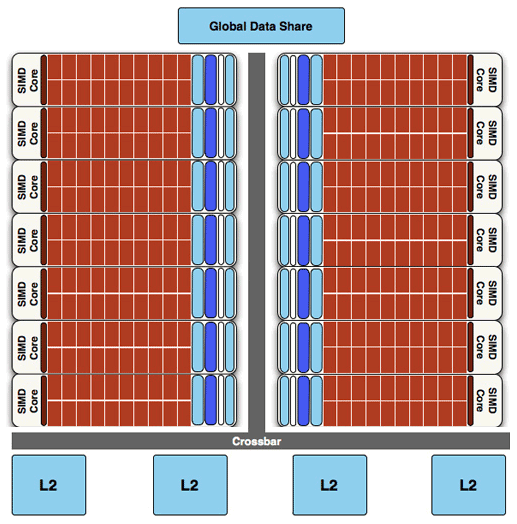
The clockspeeds on the 5830 will be 800MHz for the core clock, and 1GHz (4GHz effective) for the memory clock. AMD tells us that the higher core clock is to help compensate for the ROP loss, while the memory clock is unchanged from the 5850. It’s worth noting that the 5830’s clock speeds have clearly been in flux for some time, as the sample cards AMD shipped out to the press came with a BIOS that ran the card at 800MHz/1.15GHz, with AMD giving us a BIOS update to put the card at the right clocks once it arrived.
Overall the 5830 has the same memory bandwidth as the 5850, while in terms of core performance it has better than 5850 performance along the fixed function pipeline (due to the higher core clock), 85% of the 5850’s performance in shader/computation/texturing activities, and 55% of the 5850’s pixel fillrate and Z/stencil performance due to the disabled ROPs. In a lot of ways this makes the card half of a 5850 and half of a 5770 – the latter has around 75% of the 5830’s shader performance and the same 16 ROPs, albeit ones that are actually clocked higher than the 5830 and giving the 5770 a slightly higher pixel fillrate.
Unfortunately disabling further units on Cypress isn’t enough to make up for the cost of running the chip at 800MHz instead of 725MHz like the 5850. The higher core clock requires a higher operating voltage (we suspect 1.175v), and as such the 5830 ends up having a higher load power than the 5850: 175W under load, versus 151W for the 5850 and 188W for the 5870. Idle power usage benefits from this situation however since idle clocks are fixed at 157/300 across the 5800 series; the extra disabled units bring idle power usage down from 27W on the 5850/5870 to 25W on the 5830.
Given the 175W load power, it shouldn’t come as a surprise that AMD and its partners are doing some recycling on board designs. The launch 5830s will be using the 5870’s board due to the similar power usage of the two cards. This is something that AMD says may change in the future if vendors want to do their own boards.
However while the 5870’s board is being used here, the 5870’s shrouded cooler is out. In fact any kind of reference design is out as AMD isn’t doing one. Instead this is going to be an AIB launch, so each vendor is going to be doing a custom design which at this point would entail a 5870 board with a custom cooler. Since the review samples that went out were 5870 cards with the appropriate functional units disabled on the GPU we don’t have any first-hand cards to show you, but AMD did send along a collection of photos from their vendors, showing how each vendor is equipping their 5830. The lack of a reference design for the 5830 also means that you can expect some significant variation in what the thermal and noise characteristics of the shipping cards are, as some of these coolers are significantly different.
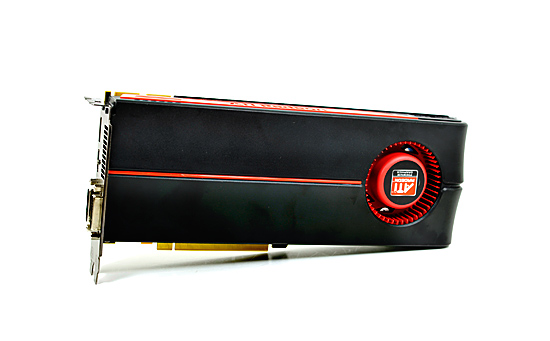
Our sample 5830: A 5870 housing a 5830 GPU
Update: It looks like AMD's partners have been able to come through and make this a hard launch. PowerColor and Sapphire cards have started showing up at Newegg. So we're very happy to report that this didn't turn out to be a paper launch after all. Do note however that the bulk of the cards are still not expected until next week.
With that out of the way, it’s time for the bad news: this is more or less a paper launch. The chips are done (AMD has practically been stockpiling them since August) but AMD has decided to jump the gun on this announcement so that they can announce the 5830 before CeBit next week, where they believe the launch would get lost among the myriads of other products that will be launched at that time.
At this point the production of the final boards is running a week later than the launch itself, which AMD is attributing to the fact that their partner’s factories were shut down earlier this month for the Chinese New Year. Two of AMD’s partners are hoping to have cards to e-tailers on time for this launch, but as of half a day before the launch no one is sure whether they’ll make it. Realistically you’re looking at the middle of next week before the cards are widely available.
We’re not amused by any of this, and we’ve told AMD as such. Paper launches were supposed to be something long-gone, and while this isn’t nearly as bad as what we’ve seen in previous years where products were paper launched solely to discourage consumers from buying a competitors product (there isn’t an NVIDIA product to counter at this point), this is still a paper launch, and there’s nothing good about a paper launch. This is a very bad habit to get in to.
And while we’re on the subject of supplies, we asked AMD what the continuing supply of the 5830 would be given that it’s a product of die harvesting, and the supply of its precursor the 4830 thinned out after some time. AMD tells us that they expect to be able to produce the 5830 in similar quantities as the 5850, which should give you an idea in relative terms of how many Cypress chips are coming back with 1-2 defective SIMDs or are missing clock targets, versus the number of chips coming back with 3-6 defective SIMDs or a defective ROP.
Finally there’s the second piece of bad news: the price. AMD is estimating $240 at launch for these cards, and we’ve seen that the price on the 5000 series can be quite variable. In terms of performance the 5830 is closer to what would be a Radeon HD 4880 with DX11, so you’re looking at a card that is going to underperform the 4890 and still cost at least $40 more. Of course at this point you can’t buy a 4890 (or a GTX 275) so AMD isn’t facing close competition at this performance level, but based on the historical pricing of the 4890 we strongly believe that $200 is the sweet spot for the 5830 right now.
Also Announced: Radeon HD 5870 Eyefinity 6 Edition
While we were being briefed about the 5830, AMD also used the opportunity to tell us about the 5870 Eyefinity 6 Edition. You may better know this card as Trillian, a card that AMD was showing off (but not naming) all the way back at their 5800 series launch event in September. The 5870E6 is the 6 port mini-DisplayPort card that AMD was using to drive their 6 monitor and 24 monitor setups during the event.
AMD is finally ready to launch the card (and we’re assuming the 6 display Samsung mega-monitor is done too) which is why AMD is announcing it today. We have the complete specs of the card, but AMD is not quite ready to discuss its performance so we have yet to receive a sample card nor can we talk about its expected performance until a later date.
| AMD Radeon HD 5970 | AMD Radeon HD 5870E6 | AMD Radeon HD 5870 | AMD Radeon HD 5850 | |
| Stream Processors | 2x1600 | 1600 | 1600 | 1440 |
| Texture Units | 2x80 | 80 | 80 | 72 |
| ROPs | 2x32 | 32 | 32 | 32 |
| Core Clock | 725MHz | 850MHz | 850MHz | 725MHz |
| Memory Clock | 1GHz (4GHz data rate) GDDR5 | 1.2GHz (4.8GHz data rate) GDDR5 | 1.2GHz (4.8GHz data rate) GDDR5 | 1GHz (4GHz data rate) GDDR5 |
| Memory Bus Width | 2x256-bit | 256-bit | 256-bit | 256-bit |
| Frame Buffer | 2x1GB | 2GB | 1GB | 1GB |
| Transistor Count | 2x2.15B | 2.15B | 2.15B | 2.15B |
| TDP | 294W | 228W | 188W | 151W |
| Manufacturing Process | TSMC 40nm | TSMC 40nm | TSMC 40nm | TSMC 40nm |
| Price Point | $599 | >$400 | $400 | $300 |
In a nutshell, the 5870E6 is a 2GB version of the 5870 equipped with 6 mini-DisplayPorts for its output. The core and memory clocks are the same as the regular 5870, while the extra RAM is to cover the larger framebuffer that would be required for such a large surface (6 1080P monitors would be 12.5MP). AMD has to equip the card with 16 GDDR5 chips in 16bit mode (as opposed to 8 chips in 32bit mode) to get 2GB of memory, so the power usage of the card will be 228W under load, and 34W idle. This means it will take a 6pin PCIe power plug and an 8pin power plug to drive the card, the only 5800 series card to have such a requirement.
AMD will once again be using the 5800/5900 series trademark shrouded cooler, this time with a full vent along the second slot to deal with the additional heat from the extra GDDR5 chips. At this point we don’t know how long the card will be, although we wouldn’t be surprised if it ended up being longer to fit the extra GDDR5 chips and power circuitry.
In order to drive adoption and to make things a bit easier for buyers, AMD will be having their partners include a number of dongles with the card so that no one is caught completely off guard by the exclusive use of mini-DP. The 5870E6 will come with 2 mini-DP to DP dongles, 2 mini-DP to single-link DVI dongles, and a single mini-DP to HDMI dongle. This will give the 5870E6 a similar degree of output flexibility as the 5870, even though it’s composed entirely of mini-DP ports.
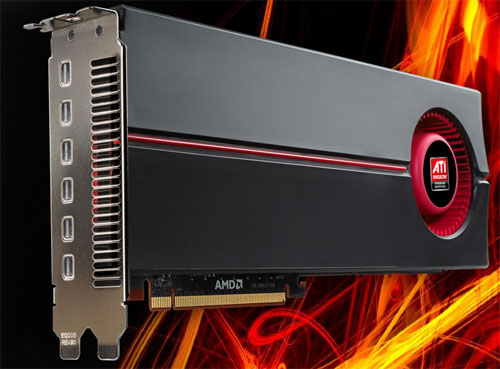
Since this is still being driven by Cypress, the clock source limitation has not changed. Cypress only has 2 clock sources for DVI-type displays, so the 5870E6 can only drive up to 2 DVI/HDMI displays using passive adapters. Furthermore if you want to drive a 2560 display or a 120Hz 1920 display, you’re going to need active adapters regardless of clock sources. So if you’re thinking of buying this as a 2GB 5870 to drive your 2560 DVI monitor, you’re still going to be shelling out another $100 for an active adapter. Even with the dongles, it’s clear that this card really is meant to be paired with DP/mini-DP monitors for the long-run.
As for pricing information, AMD has not announced a final price for the card. But since the regular 5870 is already at $400 it’s safe to tell you that this card will be in excess of $400.
Finally, we’re left wondering whether this card is a bit ahead of its time. Eyefinity is certainly ready (particularly with the Catalyst 10.3 driver additions that will be coming) but AMD’s current power situation means that they can either offer a 2GB 5870 or a 2GB (1GB effective) 5970, but not a 4GB (2GB effective) 5970. Based on our reviews of the 5870 and 5970 we’re not convinced that a 5870 is fast enough to drive 6 monitors and run games at a high level of detail at the same time, and at the same time more memory would seem to be critical for the frame buffer size that would result from such a setup. With Crossfire Eyefinity fully working as of the Catalyst 10.2 drivers, we suspect anyone serious about a 6 monitor setup is going to want to go for a pair of these cards in Crossfire mode so that they have the rendering performance to drive such a high resolution display. It would be costly (>$800) but then again so would a 6 monitor setup.
We’ll have more on the 5870 Eyefinity 6 Edition once it launches.
The Test
The drivers AMD shipped with the Radeon HD 5830 are version 8.703 RC2, dated February 11th.
| CPU: | Intel Core i7-920 @ 3.33GHz |
| Motherboard: | Intel DX58SO (Intel X58) |
| Chipset Drivers: | Intel 9.1.1.1015 (Intel) |
| Hard Disk: | Intel X25-M SSD (80GB) |
| Memory: | Patriot Viper DDR3-1333 3 x 2GB (7-7-7-20) |
| Video Cards: |
AMD Radeon HD 5970 AMD Radeon HD 5870 AMD Radeon HD 5850 AMD Radeon HD 5830 AMD Radeon HD 5770 AMD Radeon HD 5750 AMD Radeon HD 5670 512MB AMD Radeon HD 4890 AMD Radeon HD 4870 1GB AMD Radeon HD 4850 AMD Radeon HD 3870 AMD Radeon HD 4770 AMD Radeon HD 4670 512MB NVIDIA GeForce GTX 295 NVIDIA GeForce GTX 285 NVIDIA GeForce GTX 275 NVIDIA GeForce GTX 260 Core 216 NVIDIA GeForce GTS 250 NVIDIA GeForce 8800 GT |
| Video Drivers: |
NVIDIA ForceWare 190.62 NVIDIA ForceWare 195.62 AMD Catalyst Beta 8.66 AMD Catalyst Beta 8.66.6 AMD Catalyst 9.9 AMD Catalyst Beta 8.69 AMD Catalyst RC 8.703 |
| OS: | Windows 7 Ultimate 64-bit |
Crysis: Warhead
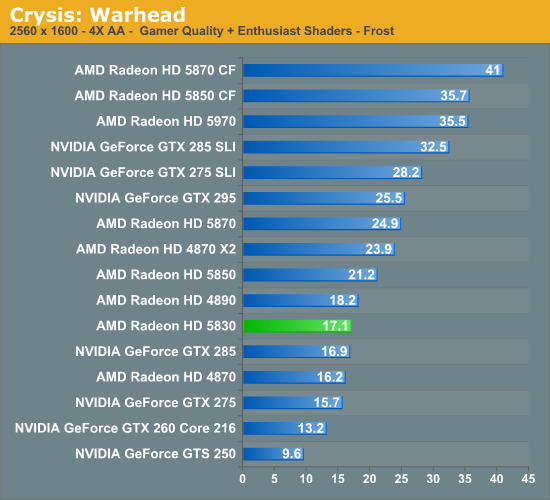
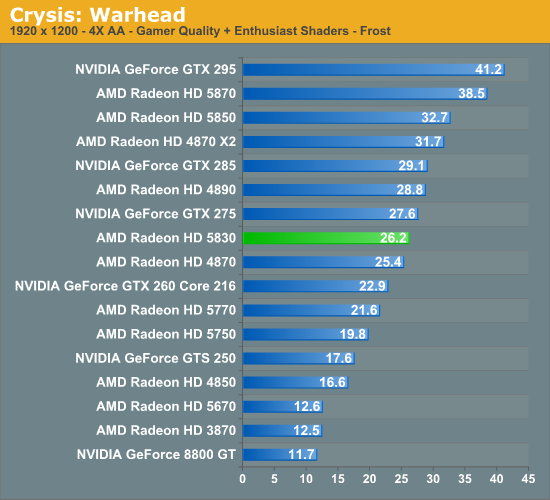
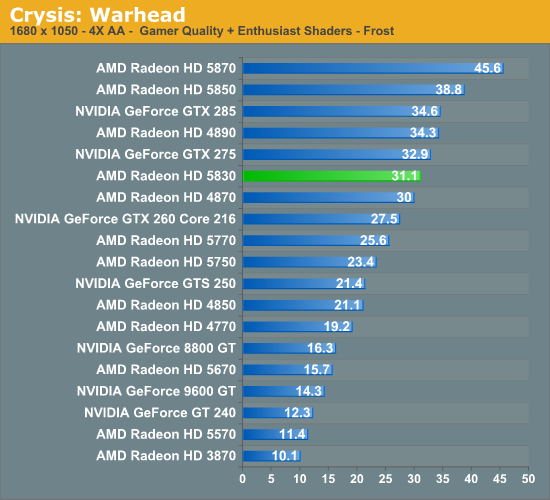
Being our most stressing game, Crysis also tends to generate some of our most interesting results. Right off the bat at 2560 we have the 5830 beating the GTX 275 by 9%, the 4870 by 5%, and losing to the 4890 by 6%. But lower that resolution and we fall in to another pattern: 10% under the 4890, 6% under the GTX 275, 3% over the 4870, and 20% under the 5850.
Crysis is a game where we expected the ROP loss to hurt the most, but that clearly isn’t the case. The 5830 does have the unfortunate distinction of being the first 5800 series card to drop below 30fps at 1920 however, a resolution the 5850 and 5870 can sustain.
Far Cry 2

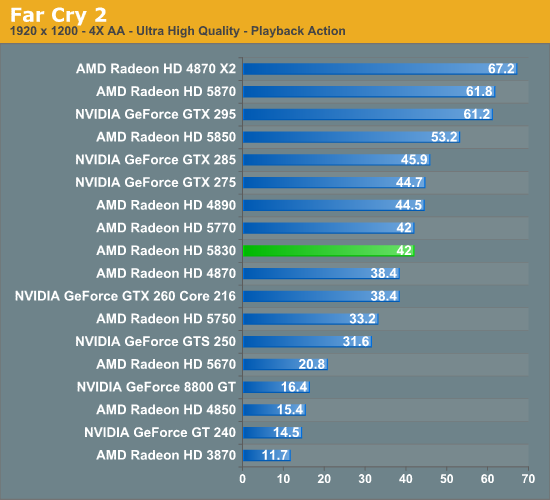
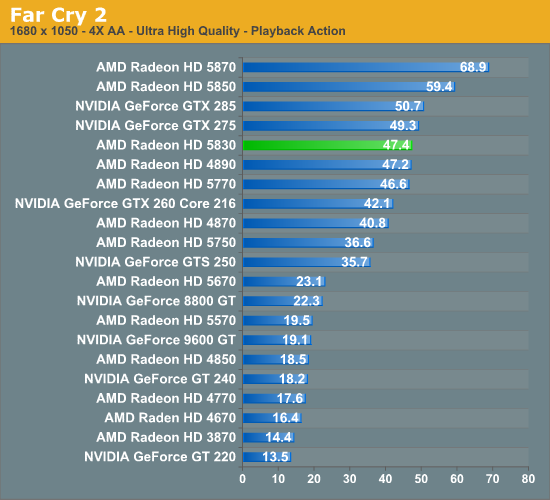
At 2560 we have a dead heat between the 5830, the GTX 275, and the 4890. Meanwhile the 5830 is 15% ahead of the 4870 and 18% behind the 5850. This general trend continues at 1680, and it slightly underperforms at 1920, likely because this is the highest resolution we use anti-aliasing at and where the ROP penalty would be the most severe.
BattleForge
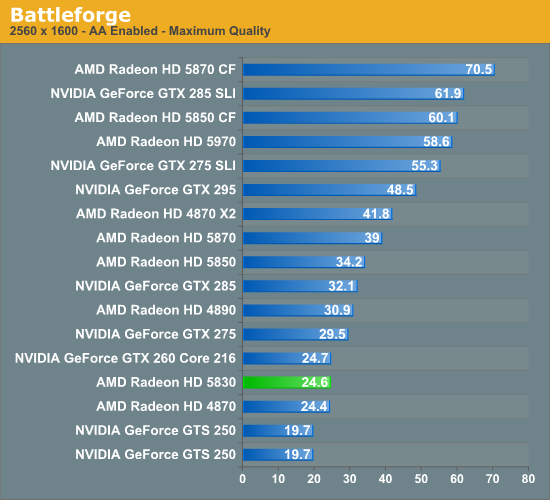
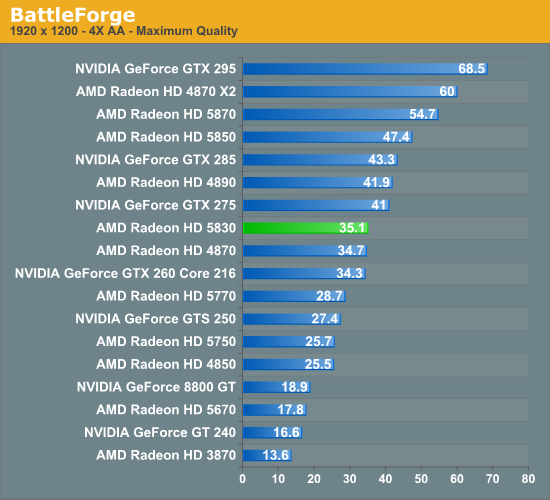
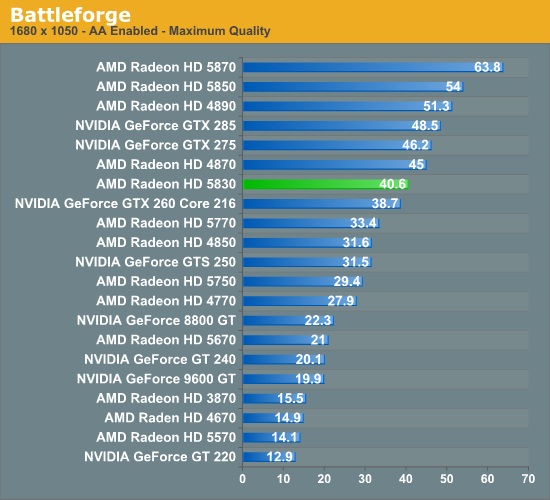
BattleForge is a game we have always taken as being shader-heavy, which is what makes our results here so interesting. While Far Cry 2 was a dead heat between the 5830/4890/GTX275, BattleForge quickly separates the cards. We’re anywhere between 15-20% slower than those cards, leaving the 5830 to hang with the 4870 most of the time, and to even lose there at 1680. Meanwhile against the 5850, it’s 25-30% slower.
Given that the 5830 has a higher ratio of shader power to rendering than any of these other cards, our best conclusion is that BattleForge is in fact a ROP-heavy game when not completely starved of shader power. The result is that the 5830 is placing near a card that costs some 33% less. It’s clear that the impact of cutting the ROPs in half will vary from game to game.
HAWX
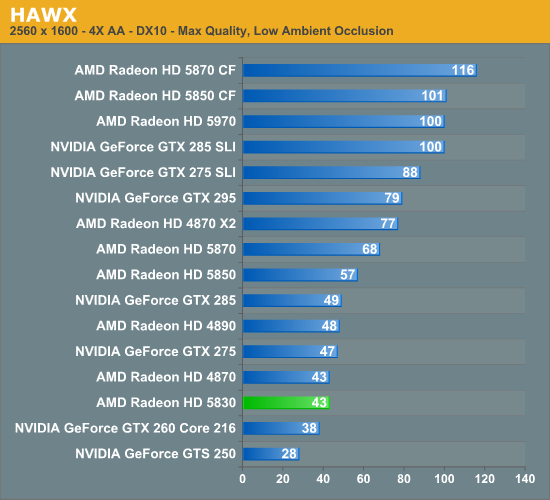
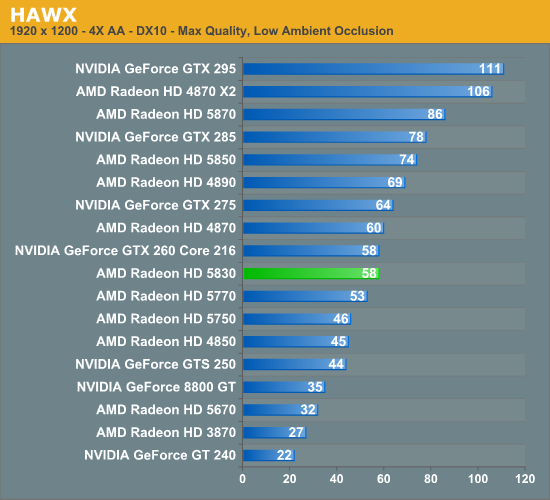
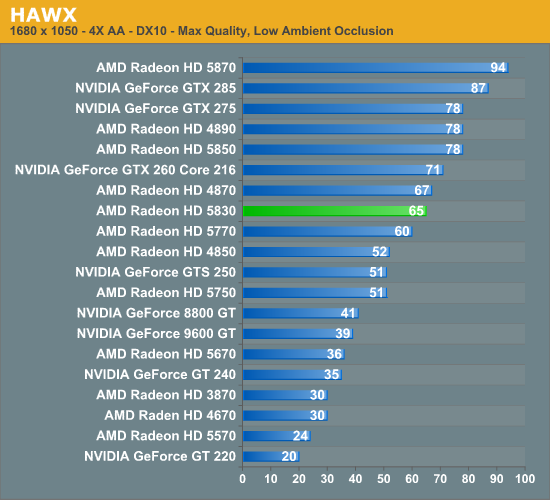
HAWX is another bad game for the 5830 – it falls behind the 4890/GTX275 by 10-17% depending on the resolution, and even the 4870 is once more keeping up. Compared to the 5850 the results are a little more spread, coming out as 17-25% slower with the penalty increasing with the resolution.
Dawn of War II
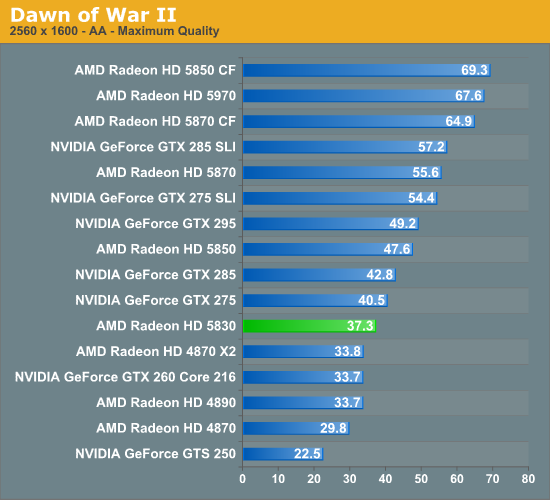
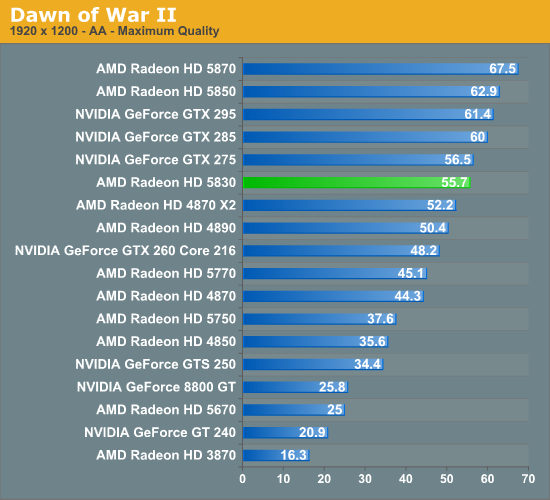
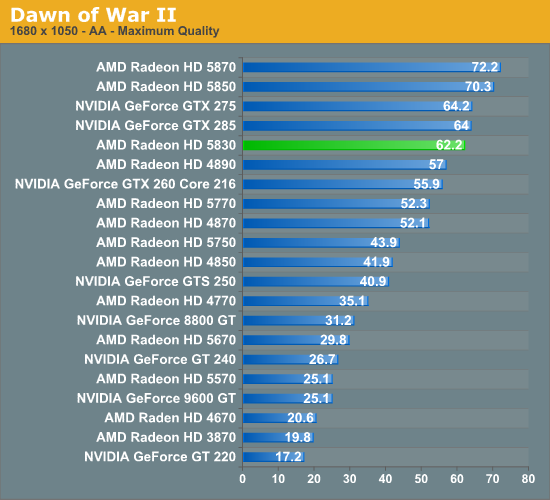
Dawn of War II will end up being the best game for the 5830. It can’t beat the GTX 275, but it overshoots the 4800 series by 10-25%. Even against the 5850, it comes as close as 12% slower. Overall the 5830 seems to do better at lower resolutions, which isn’t surprising given the lower ROP count.
Resident Evil 5
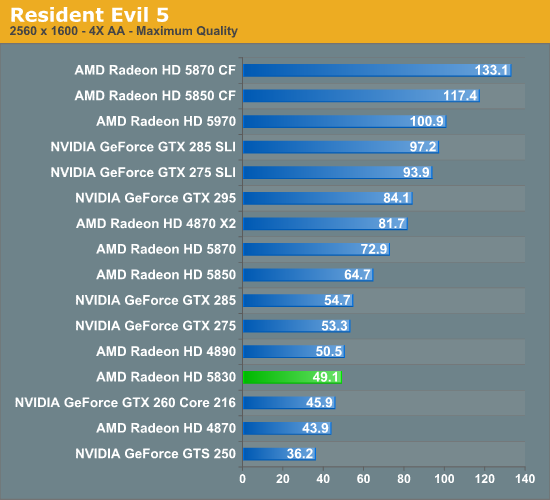
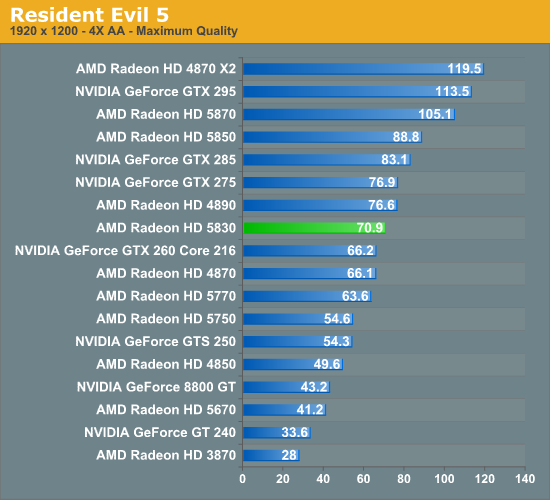
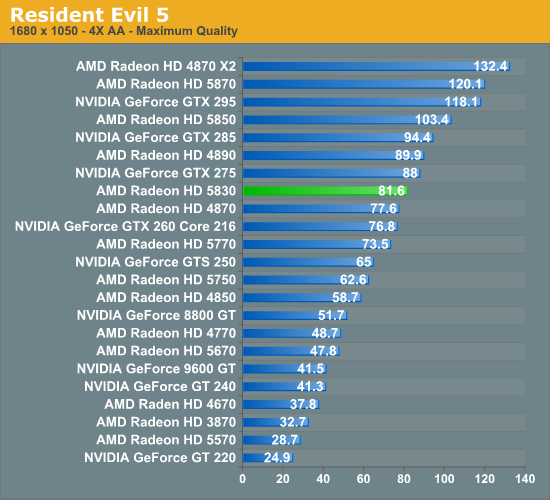
Resident Evil 5 begins our stretch of less GPU demanding games, but it doesn’t seem to have had much of an impact on the results. Compared to the 4890/GTX275 the 5830 is around 10% slower, and 5-10% faster than the 4870. Compared to the 5850, it’s a steadfast 20-25% slower.
Batman: Arkham Asylum
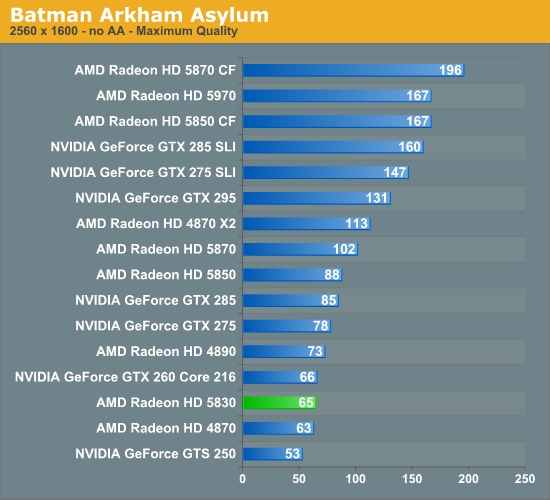
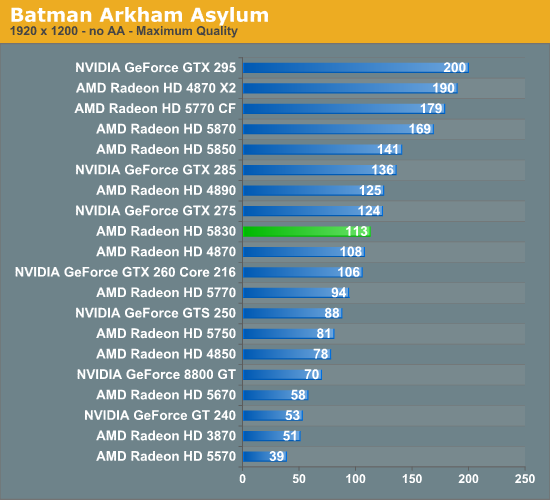
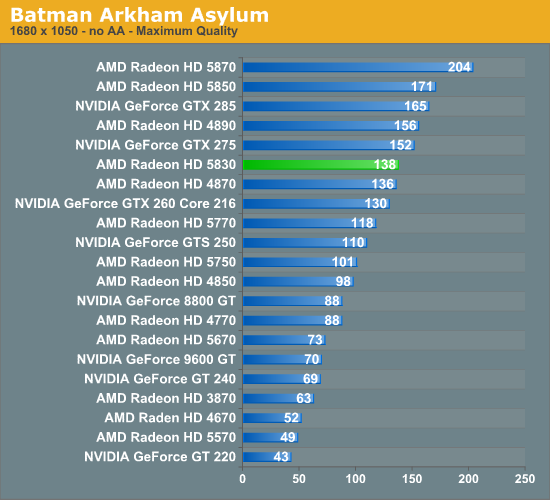
Since we don’t use anti-aliasing on Batman, this benchmark lets the framerate fly through the roof and reduces some of the pressure on the ROPs. Even so, the 5830 is a consistent 10-15% slower than the 4890/GTX275, and barely any faster than the 4870. The gap between it and the 5850 stays between 20% and 25% in favor of the 5850.
For 2560 in particular, even without the use of anti-aliasing, our data indicates that we may still be held back the most by the ROPs.
Left 4 Dead
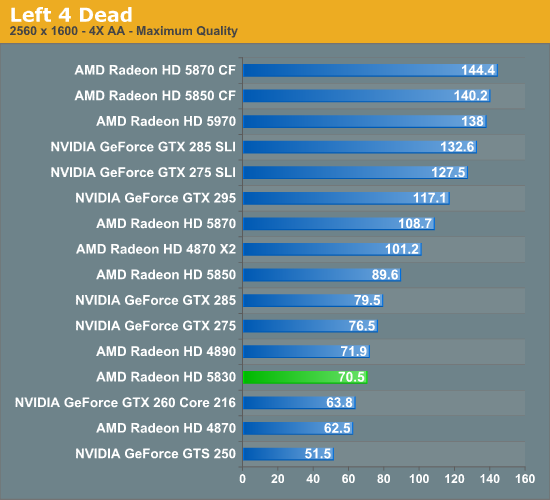
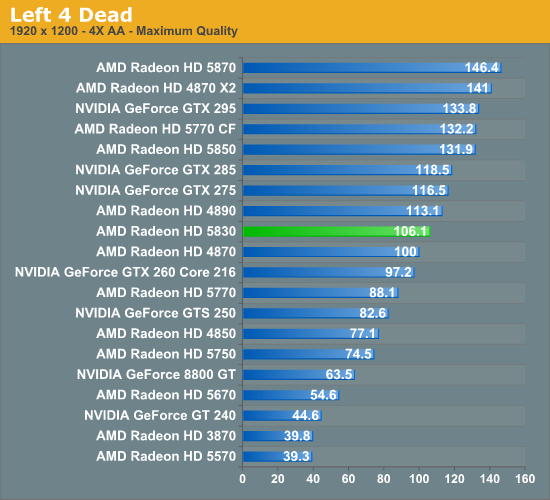
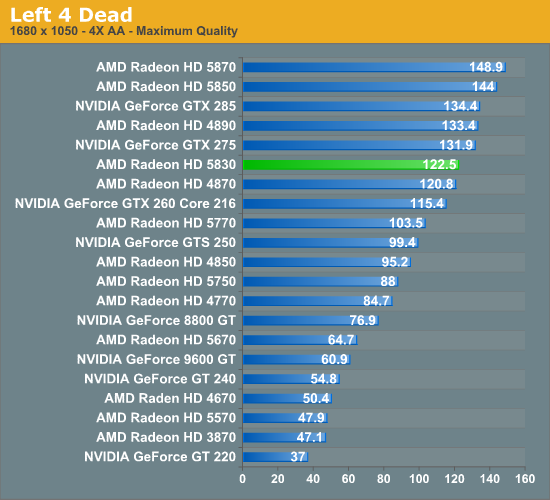
Closing things out we have Left 4 Dead. We have a bit more spread on our results here, with the 5830 coming close to the 4890/GTX275 at 2560 (a resolution it is quite fluid at), while at lower resolutions it settles in to tailing those cards by 10%. The lead over the 4870 follows a similar story, evaporating by the time we reach 1680. Finally compared to the 5850, the 5830 is once more 15-20% slower.
Power & Temperature
Since AMD isn’t doing a reference Radeon HD 5830, non-performance data is of limited value. Even with the variety of cards among AMD’s partners, the power draw of the 5830 cards should be within a few watts of each other and vary only with the difference in their fans so long as they use a 5870 PCB. On the other hand temperature data is going to heavily depend on the cooler used, and noise data is completely useless here since it entirely depends on the cooler used.
So we have power and temperature data for you, but please keep in mind that this temperature data is really only useful as a frame of reference – retail cards could be quite dissimilar.
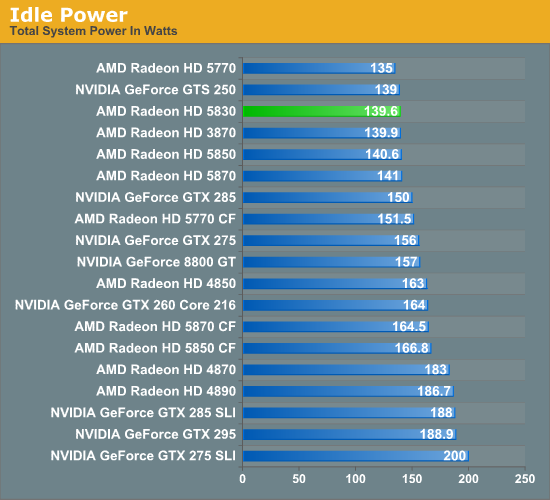
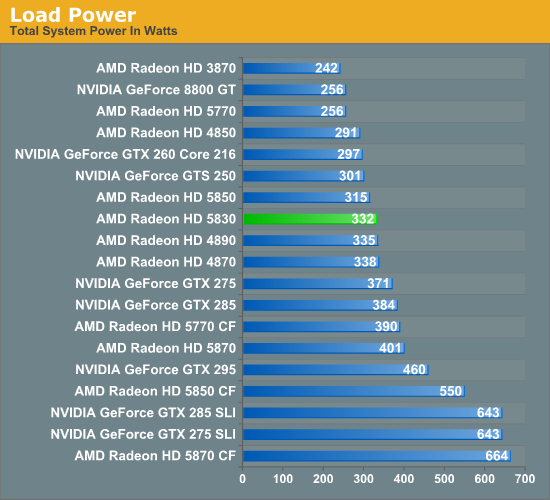
At idle, the power usage is just as AMD promised: it’s a hair under the 5850, by a single watt to be exact. As far as high-end cards go, this is the least power hungry among them when idling.
Under load the story is quite a bit more interesting. We know the 5830 is rated for a TDP between the 5850 and 5870 that’s much closer to the 5870, but the power draw doesn’t reflect that. Here it’s 17W over the 5850, and nearly 70W off the 5870. We’ve double checked and the card isn’t throttling (a very possible situation given the higher voltage used) so we’re not quite sure what to make of these results. The 5830 is apparently more alike the 5850 than the 5870 when it comes to power consumption, which is certainly a good thing since it means it edges out the 4870 and 4890, and is well ahead of the GTX 275.
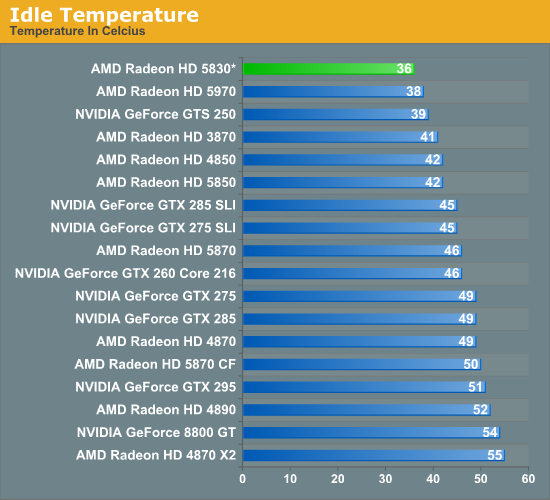
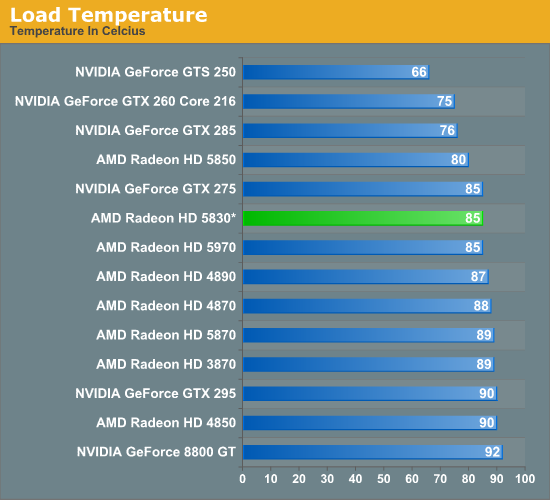
With an eye on the fact that this temperature data is going to be heavily dependent on the cooler used, for our sample card we certainly have some interesting results. Under idle this is the coolest of our high-end cards, which is no surprise given the use of the 5870’s big cooler and the lower idle power usage of the 5830. On the other hand under load, even with the otherwise minor difference in power draw compared to the 5850 and the bigger cooler it’s 5C hotter, which is actually more in-line with what we would have expected. However it still stays below the 4800 series and the 5870, both of which get warm enough that they really have to rev up their fans.
It’ll be interesting to see just how good the vendor coolers end up being. With the relatively low load power usage, the 5830 doesn’t have to be a particularly loud card.
Conclusion
The 5830 is a card that the public has had some very high expectations for coming in to this launch. The 4830 – as short lived as it was – was a well received card even if it wasn’t an immediate bargain. For anyone expecting a repeat performance on the 5830, we can’t help but feel that you’re going to come away disappointed.
On a global average, the 5830 sits about half-way between a 4890 and a 4870, or if you prefer is about 8% slower than a GTX 275 and 20% slower than a 5850. The latter is particularly interesting since it comes so close to the 5850 even though it only has 55% of the ROP capacity; clearly the hit to the ROPs didn’t hurt too badly.
At any rate, I had been expecting something that would consistently be to the north of the 4890 in performance, but the performance is what it is – there’s no bad card, only a poorly priced card.
And a poorly priced card is really what does the 5830 in. AMD expects this card to go for $240, a mere $20 below the original MSRP for the 5850; if one goes by the original MSRP of the 5850 this card is much too slow for the price. Conversely the 5830 is around 10% slower than the 4890, a card that was going for between $180 and $200 before supplies seemingly ran dry. The only price comparison where $240 makes sense is compared to the 5850’s current $300 price – you get 80% of the performance for 80% of the price. But the 5850 is priced for profit taking, it’s a fast card but it’s not a great deal.
When we were being briefed about this card, AMD’s (and former Beyond3D guru) Dave Baumann asked us to get back to him on what we thought the card should be priced at once we finished our testing. Our response to him, and the same thing that we’re holding to in this review, is that the sweet spot for this card would be $200, and the highest should be $220. $200 is a sweet spot because it picks up where the 4890 left off, even if it is around 10% slower. $220 on the other hand places a greater valuation on the 5000 series feature set, and is closer to the GTX 275.
Dave’s argument (and undoubtedly one that will resonate throughout AMD) is that the 5830 has some very useful advantages over the 4890 – DX/DirectCompute 11, Eyefinity, better OpenCL support, and bitstreaming audio. All of this is true, although the 5830 strikes us as a poor choice for Eyefinity usage (get something faster) or for bitstreaming audio (it’s not exactly a cool HTPC card). DX11 and OpenCL is harder to evaluate due to their newness, and in the case of OpenCL AMD doesn’t even distribute their OpenCL driver with the rest of their Catalyst driver set yet.
Meanwhile there’s a separate argument entirely over whether the 5830 is more future-proof (disregarding DX11) due to its higher shader throughput. Historically speaking this is a reasonable argument, but it’s also one that I’m not convinced will hold up when NVIDIA is going to be pushing tessellation instead of shading – you can’t ignore what NVIDIA’s doing given their clearly stronger developer relations.
Ultimately the problem is that being future proof comes at too high a price. The 5770 was a hard sale compared to the faster 4870, and this time we’re talking about what’s around a $60 premium based on performance over the 4000 series. AMD’s saving grace here is that you can no longer buy such a card – it’s either a GTX260/4870, or nothing.
At the risk of sounding petty over $20, a $240 5830 is $20 too much. If this were priced at $200-$220 it wouldn’t be a clear choice for the 5830, but it wouldn’t be such a clear choice against it. For $240 you can try to shop around for a 4890 and save $40-$60 while getting a card that will perform better at most of today’s games, or save even more by going with a 4870 that will slightly underperform the 5830. Alternatively you can save up another $60 and get the 5850, a card that is faster running and cooler running at the same time. There is no scenario where we can wholeheartedly justify a 5830 if it’s going to be a $240 card – this really should have been the new $200 wonder card.
Update: It looks like AMD's partners have been able to come through and make this a hard launch. PowerColor and Sapphire cards have started showing up at Newegg. So we're very happy to report that this didn't turn out to be a paper launch after all. Do note however that the bulk of the cards are still not expected until next week.
This brings up the other elephant in the room: today’s paper launch. Paper launches should by all means have died last year, but their ghost apparently continues to live on. If in fact no 5830s make it to retailers in time for today’s launch, then the card should not have been launched today – it’s as simple as that.












